Natural Beauty
The green Mediterranean landscape, the azure depths of the Adriatic, white sea cliffs…
Fragrances of herbs growing in the clearings, historical gardens, the aquarium with the most intriguing species of the sea world are a part of the heritage which the visitors discover in Dubrovnik and its surroundings.
Ecology has become a more and more important part of our life, and the protection of environment and life in accordance with nature are both our obligation and duty. We take great pride in the outstandingly preserved natural monuments, the worlds bluest and cleanest sea, the unique flora and fauna, and the fascinating subterranean caves. The arrival to Dubrovnik-Neretva County offers enjoyment in the azure sea and sky, unique sunsets and natural sights of our region.
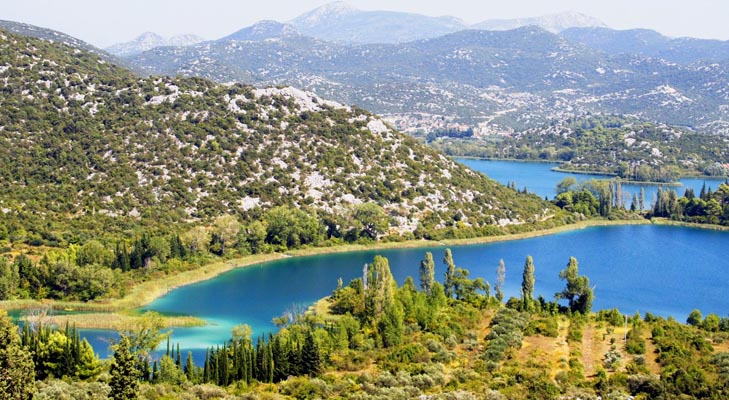
 Arboretum
Arboretum
Arboretum Trsteno is the sole arboretum at the Croatian Adriatic coast which unites cultural and natural heritage in a unique abundance of values. It is known for its historical gardens and a collection of Mediterranean and exotic plant species. The collection of cultivated species of plants, which is mostly located within the Renaissance garden, today amounts to about 465 taxa, which are classified into 111 families. According to the plant-geographic origin of the species, the largest number belongs to Mediterranean and European plants (31%), followed by Asian (22%), and a significant number of American plants (17%).
The Arboretum was established at the former land estate of the Dubrovnik patrician family Gučetić-Gozze in 1948 and has been protected by law as a monument of garden architecture. On its 25.61 hectare area (64 acres), the Arboretum integrates several different units: the historical Renaissance garden and villa, the historical neo-romantic garden from the beginning of the 20th century, the historical olive grove, as well as the natural vegetation of the downy oak, the Aleppo pine and the Mediterranean cypress woods, mscchia and coastal rock vegetation.
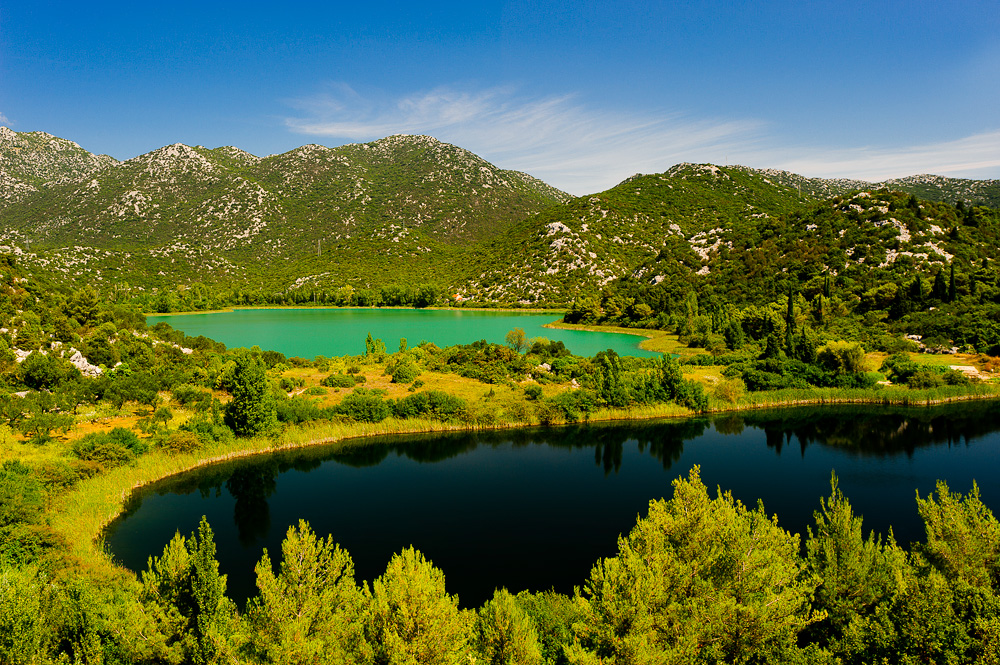 Baćina Lakes
Baćina Lakes
Bacina Lakes are a frequent tourist destination and a place of beauty which must be visited. They abound in freshwater fish, but there are also grey mullets, which made the lakes their natural habitat after the tunnel drilling. This region is most famous for its gastronomic specialities. Eels, black water hens and frogs legs, amongst others, are specialities of the Dalmatian kitchen and present an excellent reason to visit the area. The area is a true promised land for nature-lovers and anglers.
On the locality of Sladinac are the remains of antique walls and mosaics belonging to the Roman habitation Praetoria. The remains of an early Christian basilica from the 6th century have been found here. A necropolis of stelae, mostly sarcophagi and slabs, has been found next to the ruins of the church of St. Andrew.
Trade brought the ancient Greeks to this area, and during the time of ancient Rome the area was a part of the province of Dalmatia. The city of Narona, located near the lakes, was then one of the largest economic end cultural centres on the Adriatic Coast.
Bacina Lakes, a pearl of unspoiled nature, consist of seven lakes, six of them forming a bluish green necklace. The lakes are located between the Neretva River Delta, the sea and the surrounding mountains, in the place of Bacina, close to Ploce, on the main road (M2).Their names are: Ocusa, Crnisevo, Podgora, Sladinac, Vrvnik and lake Plitko. The entire area of the lakes amounts to some 20 square kilometers. Their depths range from 5 to 50 m. The water in the lakes is brackish, meaning they are connected with the sea. The lakes are a cryptodepression, because the surface of the lakes lies 80 cm above sea level and the bottom of the lakes lies below sea level. Therefore, salty water can be found at the bottom of the deepest, 50 m deep ,lake Crnisevo. The lakes have two water sources. One of them is a salt water source in lake Crnisevo, and the other one, a natural fresh water source, in lake Ocusa.
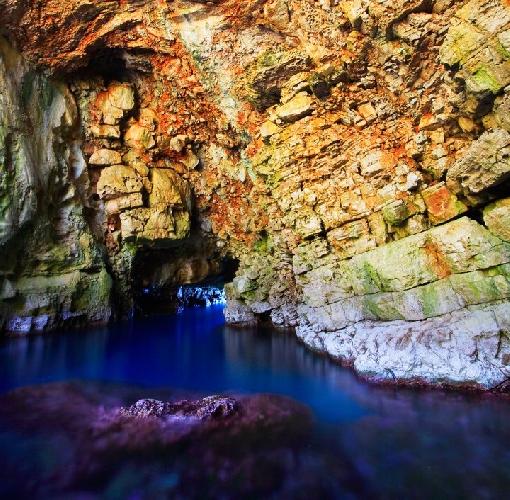 Caves – Mljet
Caves – Mljet
Odysseus cave
On the south part of the island you can find Odysseus cave which is an geomorphology phenomena. It is a karst hole which looks like a pit. It is connected with open sea by small and low tunel, through wich it is possible to pass just during nice weather. Along the coast you can find couple of little boats, which are in propriety of local people from Babino Polje, and Babino Polje is the biggest village on the island. According to legend, after his shipwreck on the island of Ogigija, Odysseus spent seven years looking at offing to his home and beloved Penelopa, while beautiful nymph Kalipso, Posejdon’s daughter, was looking at the same time, with love, at Odysseus.
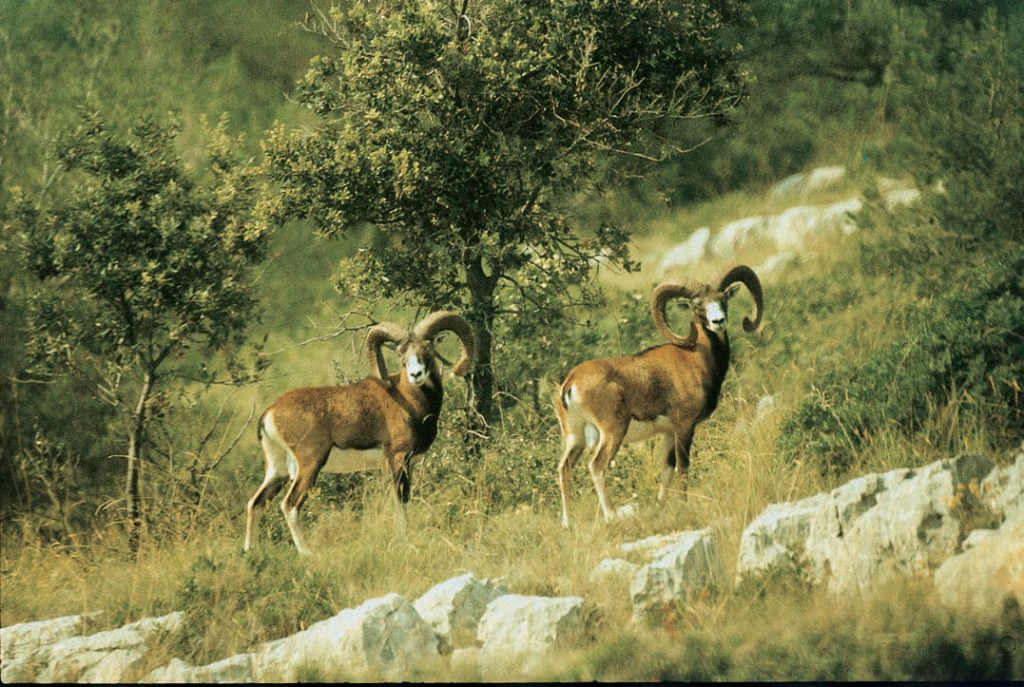 Ecology
Ecology
Ecologically, the entire county is extremely valuable and much attention is given to the conservation of nature and preserving cleanliness.
According to the claims made in 1978 by famed explorer Jean-Jacques Cousteau, Dubrovnik and the surrounding areas boast the cleanest sea in the Mediterranean.
According to the estimates of the assessment team of the European Foundation for Environmental Education, the environment of the Miho Pracat Marina was awarded a “Blue Flag”. The “Blue Flag” symbolizes a preserved, safe and comfortable environment suitable for rest, recreation and sport. For beaches and marinas, flying the blue flag means top quality tourism promotion, which is based on the high quality of service, the cleanliness of the sea and coastline and the facilities and cleanliness at the beaches and sea.
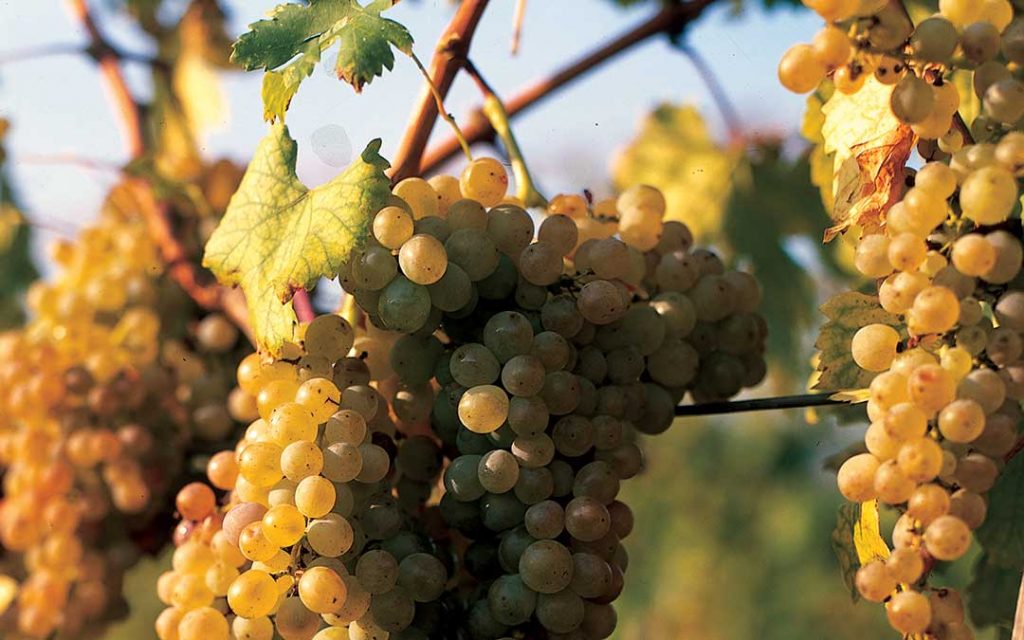 Flora and fauna
Flora and fauna
The combination of luxuriance and an active attitude of the population through the century have made this region exception in the sense of the wealth, beauty and lushness of the vegetation. In addition to autochthonous Mediterranean species of plants, this region is abundant in various subtropical and continental flora species, which are grown in numerous gardens among the Dubrovnik summer homes spread throughout the whole of the Dubrovnik coast and the islands. This region receives a particular charm from the numerous plantations of lemon trees, orange tree and various palms and agave plants, in addition to forests of Aleppo pine and holm oak, and various species of macchia (strawberry tree, heather and Spanish broom). The sea is rich in both flora and fauna. There are abundant colonies of brown, green and red algae. Many animal species can be found living on or near the sea floor, the majority of which spent most of their time living among the algae, while others prefer the sheer underwater cliffs and others yet live hidden among the cracks in the limestone or cliffs. In the dense algae, many species of fish can be found roaming in search of a tasty bite: grey mullet, saddled bream, painted comber and the annular sea bream. Fish species that live on the rocky sea bottom include the sea bass, common dentex, red scorpionfish, comber, common pandora and others. Various species of crabs, shellfish and octopus can be found hiding among the rocks on the sea floor. Here one can also find many shellfish, oysters and mussels. Also in this habitat are the most sought after residents of the southern Adriatic Sea: the lobster, crayfish and large crabs.
The county has a large number of protected nature areas within its territory. Of the total 95 valuable nature areas, 38 are registered and proposals have been made to protect 57. Only recently, scientists of the Dubrovnik Laboratory of the Split Institute for Oceanography and Fisheries discovered a previously unknown species of medusa in the waters of the Malo Jezero (Small Lake) in Mljet National Park. This species of medusa, measuring 55 centimetres in diameter, is estimated to be 26 million years old.
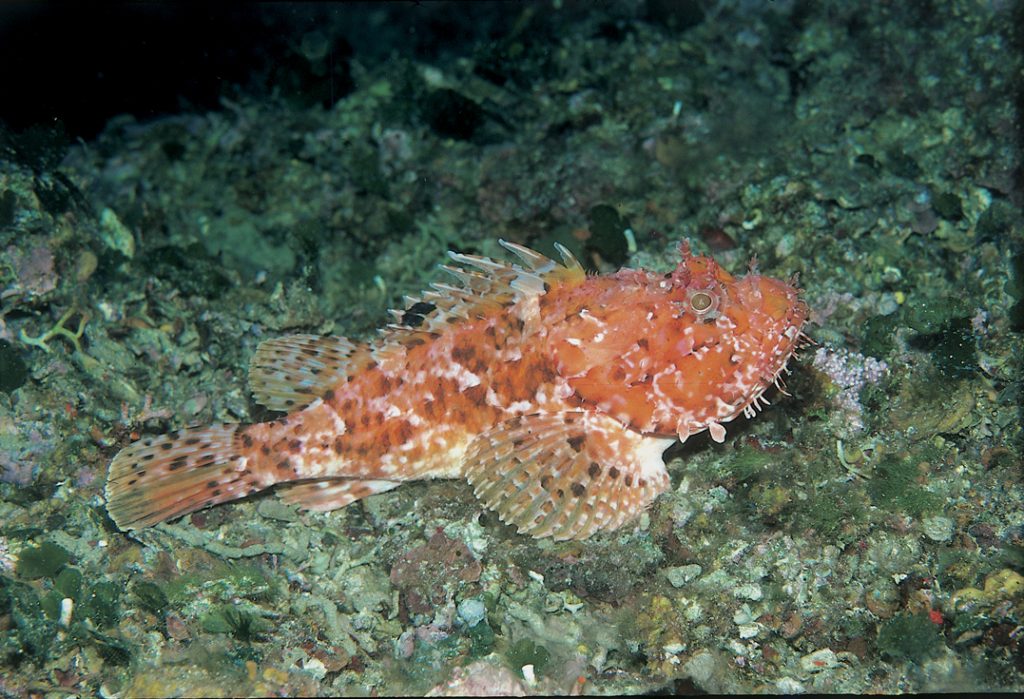 Flora and Fauna Lastovo
Flora and Fauna Lastovo
The Lastovo Archipelago is one of the richest and best preserved botanical areas in the Mediterranean. The flora on Lastovo is determined by the isolation of the open sea, plenty of sunlight and night humidity, as well as the special and deep Lastovo soil. There are 810 species recorded so far, including endangered species, species extinct elsewhere, endemic and steno-endemic species.
Besides Aurinia leucadea, an interesting and rare plant, one must point out Ampelodesmos mauretanica, a plant only found on Lastovo, as well as the steno-endemic and strictly protected species Biserrula pelecinus ssp. dalmatica.
The flora on the island of Sušac has been affected by the lack of water on scarce soil and constant exposure to strong southerly winds. This specific flora includes 278 plant species; among the eight endemic ones, one must point out Brassica cazzaem, which grows in the cracks of rocks along and near the shore.
Around 70% of the islands’ surface is covered with forest; besides Mljet, Lastovo has the most forest cover among Croatia’s islands. It is mostly covered with maquis – the most beautiful tree is strawberry tree (Arbutus unedo), but it is significantly covered with holm oak (Quercus ilex) and aleppo pine (Pinus halepensis). Mushrooms can also be found under the forest cover.
Houses on Lastovo are adorned with Mediterranean plants growing around them: almond, lemon, orange, palm and carob trees. This environment also suits medicinal plants such as sage, mint, milfoil, rosemary, lavender, fennel and camomile. Grapevines and olive trees predominate among cultivated plants.
There is also an abundance of animal life. 175 vertebrate species have been recorded so far; 71 of them are endangered at the national and 37 at the European level. Lastovo’s caves host bats that use them either as dens or breeding sites; Medjedina Cave provides shelter for 2 endangered bat species – Geoffroy’s Bat (Myotis emarginatus) and Greater Horseshoe Bat (Rhinolophus ferrumequinum).
The Lastovo Archipelago is an important resting site for numerous migrant birds and also the nesting site for the rare Mediterranean shearwater and Cory’s shearwater (Calonectris diomedea). About 70% of Croatia’s population of the globally endangered Audouin’s Gull (Larus audouinii) nests on the island groups of Lastovnjaci and Vrhovnjaci. Numerous birds of prey nest within the Lastovo Archipelago Nature Park; especially prominent among them are the Peregrine Falcon (Falco peregrinus) and the Eleonora`s Falcon (Falco eleonorae).
It is interesting that there are no venomous snakes on the Archipelago; the only snake is the Caspian whipsnake (Dolichophis caspius). The Lastovo Archipelago is also the habitat of steno-endemic lizards – the Dalmatian ruin lizard (Podarcis sicula adriatica) and the Lastovo wall lizard (Podarcis melisellensis n. ssp.). The area has an abundance of micro-fauna, especially insects, spiders and snails.
 Nature parks
Nature parks
The “Lastovsko otočje” (Lastovo archipelago) Natural Park is the most recent Croatian Nature Park
Lastovo archipelago is the eleventh Natural Park in Croatia. Its total surface area is 195.83 km2. Of this, the land surface area is 52.71 km2 whilst the surface area of the sea is 143.12 km2. The Natural Park consists of all 44 islands, islets, cliffs and reefs that make up the Lastovo Municipality. The largest islands of this group are Lastovo and Sušac. This zone is one of the most protected sea areas in the entire Adriatic. Due to its values and characteristics, it represents an “ample natural and partially fostered land and sea area that has ecologic attributes of national and international importance, with emphasized environmental, pedagogic and educational, cultural and historical as well as tourist and recreational values”. By protecting it, its heritage of environmental and cultural values as well as its biological and environmental diversity, including the sea and sea bed, will be preserved.
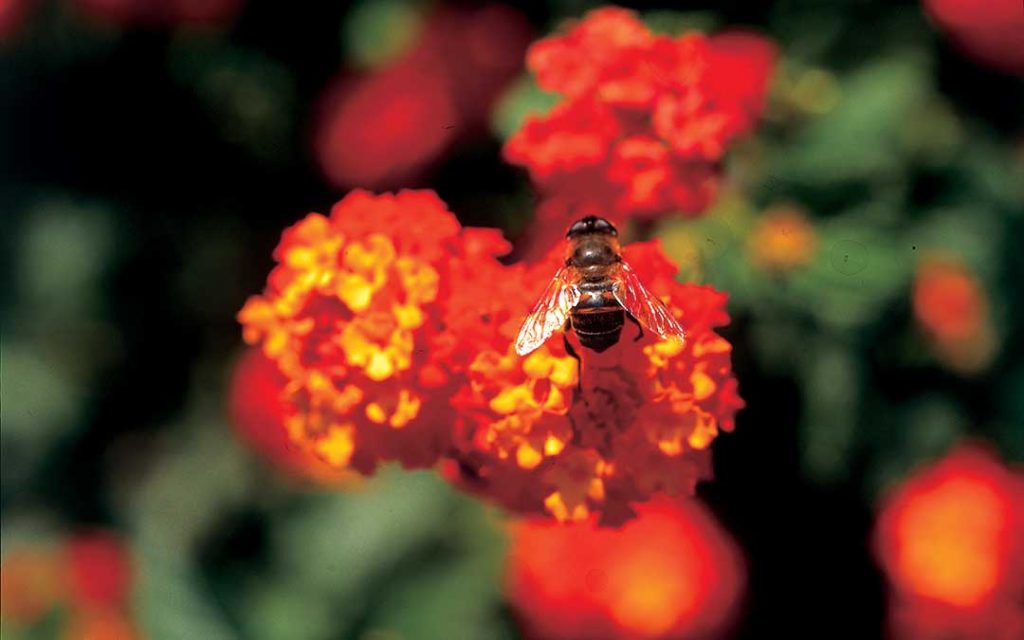 Flora and fauna Korčula
Flora and fauna Korčula
FLORA
The forests of Korčula consist mostly of Aleppo pine (pinus halepensis), coastal pine (pinus maritimus), black pine (pinus nigra), stone pine (pinus pinea) and the evergreen maritime oak “česvina” (quercus ilex).
The wild olive (olea oleaster fiori) can also be found in the woods, as well as the black ash (fraxinus ornus), the prickly juniper (juniperus oxycedrus) and others.
There are numerous cypresses (cypressus sempervirens) near the villages and roads.
A substantial part of the island is covered by “maquis”. Maquis comprises bushes of stunted coastal oak and juniper as well as arbutus (arbutus unedo), myrtle (myrtus communis), European holly (phyllirea latifolia), heather (erica arborea) and other plants. Arbutus (the “strawberry” tree) predominates in the maquis with its white flowers and sweet, bright red fruit. Cultivated bay (laurus nobilis) can be found near the villages and in courtyards.
There are very useful medicinal and aromatic plants sage, rosemary, sweet marjoram, mint. Many wild herbs such as “žutinica” are used in cooking, dressed in olive oil. Mulberry trees (white and black) used to be planted for their valuable wood. Blato has a well-known avenue lined with lime-trees and Korčula has many decorative trees, bushes and plants such as palm, tamarisk, oleander, agave, cactus, Bougainvillea and others.
FAUNA
Korčula has a varied wildlife from beetles to insects and from lizards to birds.
Its fauna includes the biggest European snake – the non-poisonous four-stripe “kravosica” which can grow to 3 metres. A particularly interesting lizard is a cephalopod with stunted legs, which many mistake for a snake, but is in fact a timid lizard useful to man.
Birds are numerous and visitors enjoy their song, from blackbirds to nightingales, as they swoop over the dense woods and fertile fields. Large owls inhabit the pines and among the birds of prey are hawks and falcons. Large flocks of migratory birds use Korčula as a staging post and sea-gulls are an obligatory part of the Korčula landscape.
The sea-gulls are an obligatory part of the Korčula landscape, and large flights of migratory birds arrive on the island during migration.
Among the mammals, there are mongoose, martens, weasels and rabbits, but of particular interest is the European jackal (“čagalj”), the last surviving pack of that genus (canis aureus). From the beginning of the eighties, wild boar, which had not hitherto inhabited Korčula, began to cross over to the Dalmatian islands in increasing numbers. The beasts of burden are donkeys and mules; and pigs, goats and sheep are kept for meat and milk.
Korčula’s waters are rich in a broad variety of excellent fish. Some will leap above the surface to be picked off by diving birds.
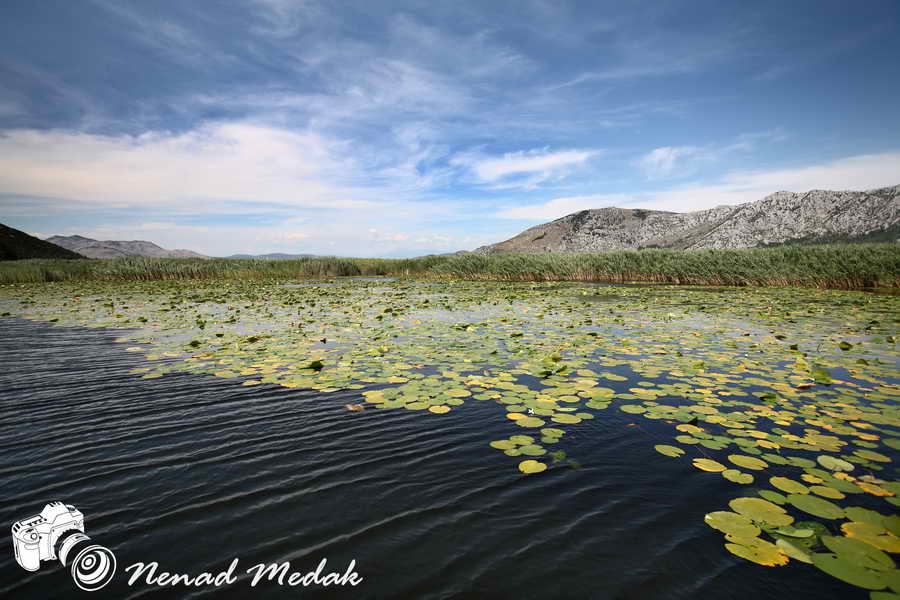 Flora and fauna Neretva
Flora and fauna Neretva
The lower Neretva area is a unique ecosystem rich with many diverse plant and animal species. The river, sea and rocky cliffs have, by working together, created conditions where a myriad of species found ideal places to live and thrive. Neretva is actually known for its diverse habitats, the rivers, meadows, forests of alder and willow, sea shore, but also those made by human hands: the fields, canals, villages. An immense swamp area has, by human interaction, been reduced to a much smaller size, to “patches” and a shadow of what they once were, surounded by swaths of land of cultivated and occupied land. Still, unlike similar lands around the world, the anthropogenic factor hasn’t been too much of a damaging impact to the valley. Its still a land of immense natural riches. Human interaction has resulted in the forestation of the surrounding hills.
In the Neretva valley, by the river mouth, we have developed areas where local plant arts grow in abundance (primorski sit, grmolika caklenjača). The brackishness of the Neretva water is a prerequisite for the rich fish types that live, feed and spawn in its waterways. Although all croatian rivers of the Adriatic Basin allow for the existence of many fish types, Neretva provides sanctuary to a far greater number of freshwater and brackish water fish types. From the most common to the most interesting types for fishing we can mention the many types of mullet and especiallly eel, an odd snake-like fish with a complicated biological cycle. It holds a two thousand year scientific interest, going back as far as Aristotle to Pliny, to the young Sigmund Freud, to modern biologists.
The eel, as is known, is born and dies in the sea, and lives in freshwater streams. There are a lot of secrets and doubts about its lifecycle, but one thing is sure: it’s delicious. The antique writer Athenaeus thought the same, and made an ode to the eel in his “Banquet of the learned”.
Amongst the many amphibians is also the green frog. It is actually a symbol of the area. We can meet it in names of certain places and one (smaller) hill, in the names of historical provinces (Frog District), but usually we’ll find it on the dinner table as one more specific gourmet meal of this area. In the pot it becomes a close companion to the eel with which it makes the traditonal neretvan stew, called brujet.
With the green frog the area is inhabited by many other amphibians and reptiles (which aren’t eaten): copperhead, blavor, karst lizard…
In the surrounding hills and the valley there are also a large number of mammals. In Neretva resides the endangered otter. Apart from the otter there are endangered wolves and wildcats. In the river delta there are 16 freshwater types of the aquatic snail and several types of crab. It’s perfectly reasonable that in such a swampy area there has to be a lot of bugs, and there are 307 types. Butterflies alone take up more than 250 types. You can explore the richness and diversity of the flora and fauna of the Neretva valley in the Natural History museum in Metković.
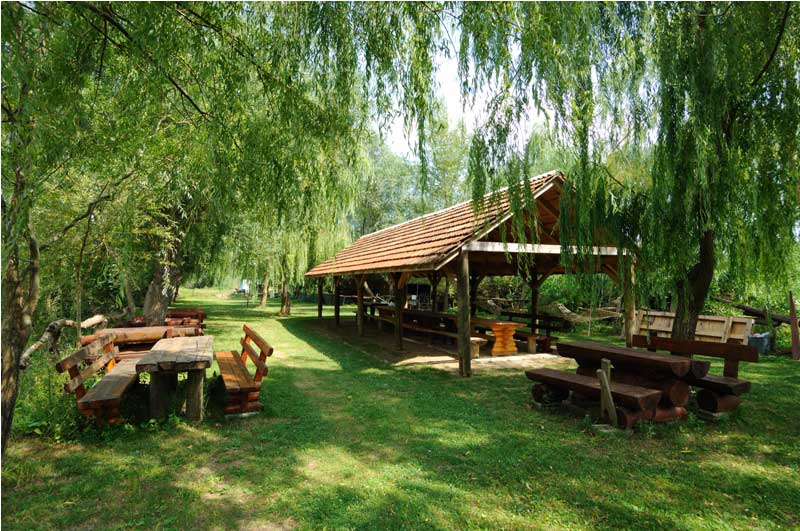 Forest parks
Forest parks
Koločep – Gornje Čelo
Aleppo pine woods with macchia thickets on the northwest part of the island of Kolocep.
Koločep – Donje Čelo
The forest on the southern part of the island of Koločep is made up of macchia thickets along the beach, as well as individually planted trees of exotic species (eucalyptus, acacia).
Osjak
An island in the Bay of Vela Luka, Aleppo pine woods.
Orebić – cypress trees “Pod Gospu”
Pyramid cypress and Aleppo pine woods on a slope next to the sea under the Franciscan Monastery of the Assumption.
Korčula – Park Hober
Just south of the city of Korčula is a Aleppo and stone pine wood, with an underbrush of macchia thickets, as well as individual pyramid and horizontal cypress, cedars, Spanish fir and agave plants.
Predolac – Šibanica
A forest east of Metković, a protected complex of Aleppo pine and pyramid cypress woods with elements of macchia thickets. Viewpoint of the Neretva valley.
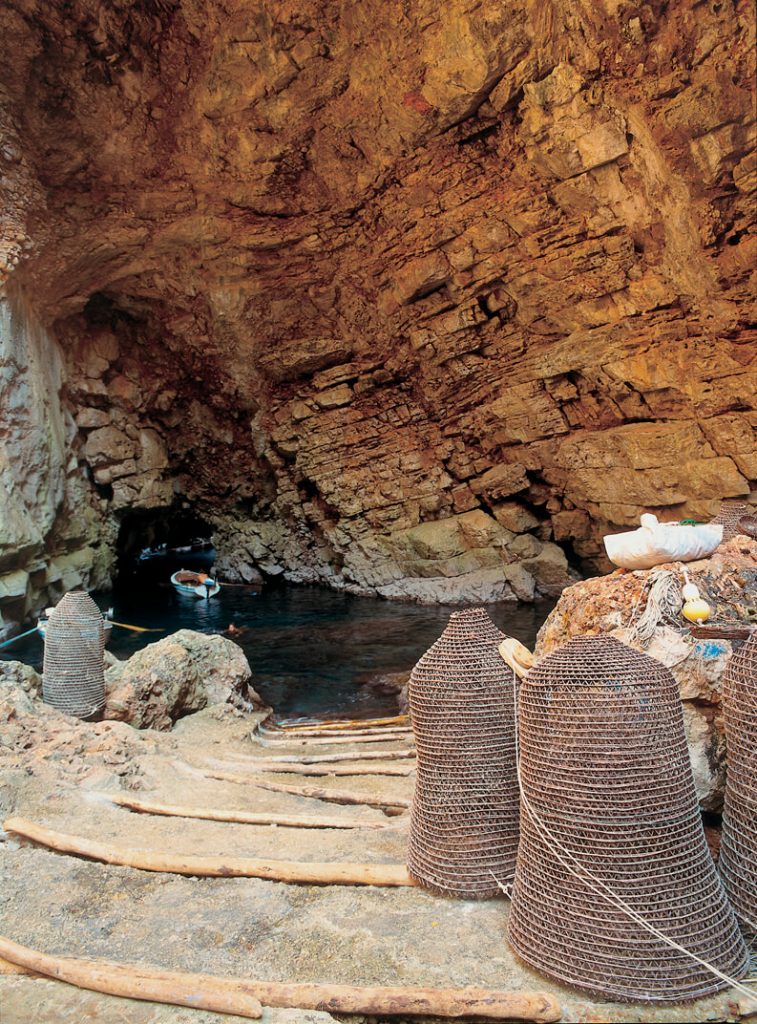 Geomorphological monuments
Geomorphological monuments
Spila Nakovana (Cave)
An unusual discovery recently turned public attention to the historical heritage of the Pelješac peninsula. Just above the village of Nakovana, in a cave called “Spila”, archaeologists discovered and studied the remains of an Illyrian shrine dating back to the Hellenist period (4th to 1st century before Christ). The entrance into the shrine was closed off by stones, and it was therefore left untouched since it was abandoned, two thousand years ago. Once the stones to the entrance were removed and the archaeologists could pass through the narrow and low passageway, they entered into a large cave hall. On the floor of the hall were thousands of shards of fine ceramic glasses, jugs, plates and small amphora. These precious and luxurious dishes were produced in the workshops of Greek colonies in southern Italy and on the Adriatic, as well as in Greece, and they came to Illyrian Pelješac through trade or by pirates. Virtually all the dishes were left before a single, 60 centimetre high stalagmite of a phallic shape. Many fine dishes for drinks and serving food and bones from goat and lamb legs testify to the ritual feasts held here. The sacrificial gifts were laid at the foot of the stalagmite, a remarkable symbol of a superhuman creature who was worshipped in the cave. We can only guess as to the attributes of this “deity”, however, the very shape of the stalagmite suggests that this cult was tied to fertility, potency or strength and courage in combat. In the final, restless centuries of pre-history, these were the most esteemed characteristics. The cave near Nakovana is the only well preserved and completely studied Illyrian shrine we know of. This is also the only “sealed” cave finding in Croatia discovered by archaeologists, and not by passers-by, such that its scientific potential has remained completely preserved. For this reason, we expect that the analysis of the findings in the cave, which are currently ongoing, will tell us much about the details of the spiritual life of the Illyrians and their gradual coexistence with classical Mediterranean civilizations.
Mocile Cave
Dry, horizontal cave near the village Pobrežje near Dubrovnik
Sipun – cave
Cave near Cavtat, interesting for its virtually completed blackened walls, fragments of ceramic dishes have been found. There is a small lake within the cave.
Raca – cave
Cave on the island of Lastovo, archaeological site.
Vela Spilja (Great cave)
Cave near Vela Luka on the island of Korcula.
Gromača Cave
Cave with a pit entrance, developed network of tunnels on several levels. Traces of footprints by early cavemen.
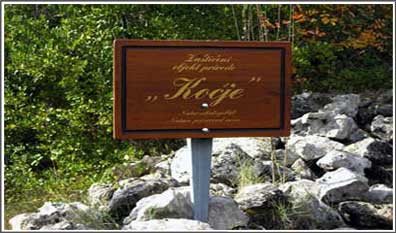 Kočje
Kočje
As one enters the village coming from Korčula, there is a road leading off to the right to Brdo (0.5km). Brdo is part of the village perched high on the hill, from where one can walk to Kočje (2.5km), through a pleasant landscape containing dolomite rock formations.
Korčula is the most densely wooded of the larger Croatian islands, with 61% of its surface forested. The remainder comprises olive groves, vines and other cultivation. Less than 5% is bare rock.
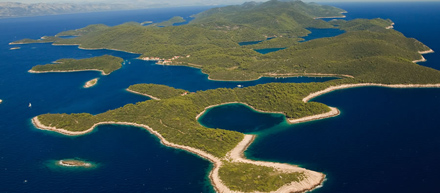 National park Mljet
National park Mljet
Situated on the island of the same name, Mljet National Park is the most important protected area of the Dalmatian south. It is the oldest National Park at the Adriatic. The park covers the western part of the island, which many regard as the most alluring in the Adriatic, full of lush and varied Mediterranean vegetation. The park includes two deep bays which, due to their extremely narrow links with the sea, are regarded as and indeed named lakes: the Great Lake and the Small Lake. Mljet is also very rich in cultural heritage, the most prominent example being the complex of the 12th century Benedictine monastery. The monastery is located on a small island in the middle of the Great Lake and is set in a lush park. Over the course of centuries, numerous chronicles, dissertations and other literary works have been written here. Located within the monastery is the church of St Mary.
For more information please visit: http://np-mljet.hr/en/
Contact
Tel: ++385 20 744 041
Fax: ++385 20 744 041
E-mail: np-mljet@np-mljet.hr
Web: www.np-mljet.hr
Address: Pristanište 2, 20226 Goveđari
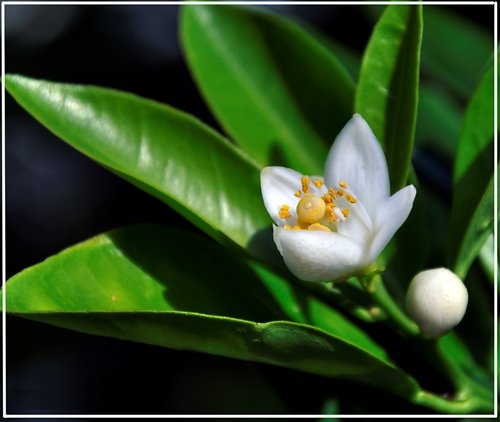 Natural heritage of island Mljet
Natural heritage of island Mljet
Geographically, Mljet is located in the open sea on the southeast Adriatic. Its location determines clime and vegetation on the island which is famous by its natural heritage: lakes, bays, sources of drinking water, steeply and rocky coast, preserved forests of holm oak tree and aleppo pine, caves, sandy coves… Those are some of the reasons why in 1960. northwest part of the island, with its area of 3000 ha, became national park. Institution for preserving natural heritage was founded in the same year.
Mljet is hilly island, the highest point is Veliki grad with its 514 meters and it is located in middle part of the island. Cliffs are made of limestone and dolomite. There are no water courses on the island, but there are several sources of drinking water. Great and Small lake on the northwest side of the island are submerged kasrst valleys filled by sea. Coastline on the island is rugged; there is great number of islets, coves and reefs.
Fauna
Rich and the interesting fauna of the island has not been fully explored yet.
From the reptiles there are a road lizard (Lacerta viridis), Sharp-lizard (Lacerta oxycephala), common lizard (Lacerta melisellensis) and the pet gecko (Hemidactilus turcicus). Snakes are quite rare (there are no poisonous) after they brought the mongoose (Herpestes auropunctatus) 1909th year. After an initial rapid increase, mongoose populations came to a certain balance with the environment.
From the mammals there are: mouse (Apodemus mystacinus), hedgehog (Erinaceus europeus), more species of bats (Chiroptera), common dormouse (Glis glis), marten (Martes foina) and common hare (Lepus europaeus). Fallow deer (Dama dama) was entered on the island after the Second World War, and more recently wild boar (Sus scrofa).
Bird world is rich and the diverse especially in the migrating season. In pine woods and the surrounding macchia live thrushes (Turdidae), tit (Paridae), Queen (Regulidae), warbler (Sylvidae) _ Hoopoe (Upupa epops), Roller (Coracias garrulus), etc. Valleys and the fields in the winter time are populated by Finch (Fringilidae), Lark (Alaudidae) and the shepherdesses (Motacilidae). Along the coast and especially on the mud lakes there are: mallards (Anatidae), grebes (Podicipidae), herons (Ardeidae) and the snipe (Scolopaeidae). In migrating here are many Falconiformes (Falconidae), and ring dove (Columba palumbus) and the stock dove (Columba oenas). At the Park nests wild pigeon (Columba livia) and the rare prey eagle owl (Bubo bubo).
The sea around the island is characterized by well preserved wildlife, distinctive from southern Adriatic.
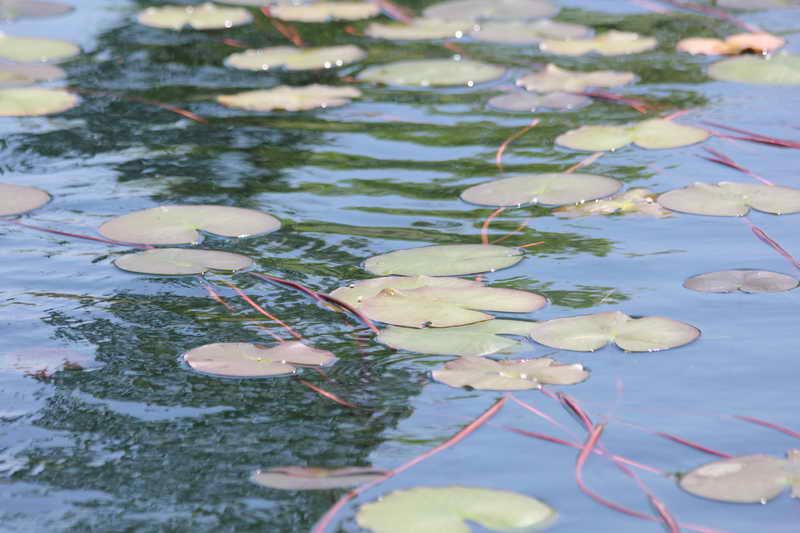 Neretva estuary
Neretva estuary
The last delta of Europe – richness at the Neretva estuary
In addition to the beautiful islands, mountains, karst and fertile hinterland, Dalmatia is proud of the latest Delta of Europe – Neretva river mouth.
The delta of the Neretva River, from Metković to the estuary on the north and northeast, is bordered by branches of the Dinaric Alps, and to the south by hills. To the west it is open to the sea and is under its constant influence. Precisely this brackish water is the right place for the growth of vegetation and fish fund. The wildlife is also diversified here – the last species of birds, which couldn’t be seen anywhere else in Europe, made their nests in this marsh area.
Climatic influences are very suitable for agriculture, for the famous Neretva tangerines and other citrus fruits, among which in the past years clementines have become increasingly popular, whereas at the beginning of the summer, it is all about peaches and nectarines. Precisely picking these cultures for years also represents a type of tourism that Neretvians have arranged for their guests. We must not forget hunting and fishing, which also brought many at the Neretva river delta… and after hunting and eels fishing, you can try preparing these delicacies, typical for this region.
In addition to these activities, even if you are not the athletic type, you will surely enjoy the photo safari through the backwaters of the river. A ride in the Neretva boat (you can paddle on your own, or choose a motor drive) through the vast backwaters, tributaries and lakes, finalized with occasional lunch at one of the many ranches (with an outdoor barbecue and homemade bread), will make one of the best memories. The Neretva River delta is a natural phenomenon, and a must-see!
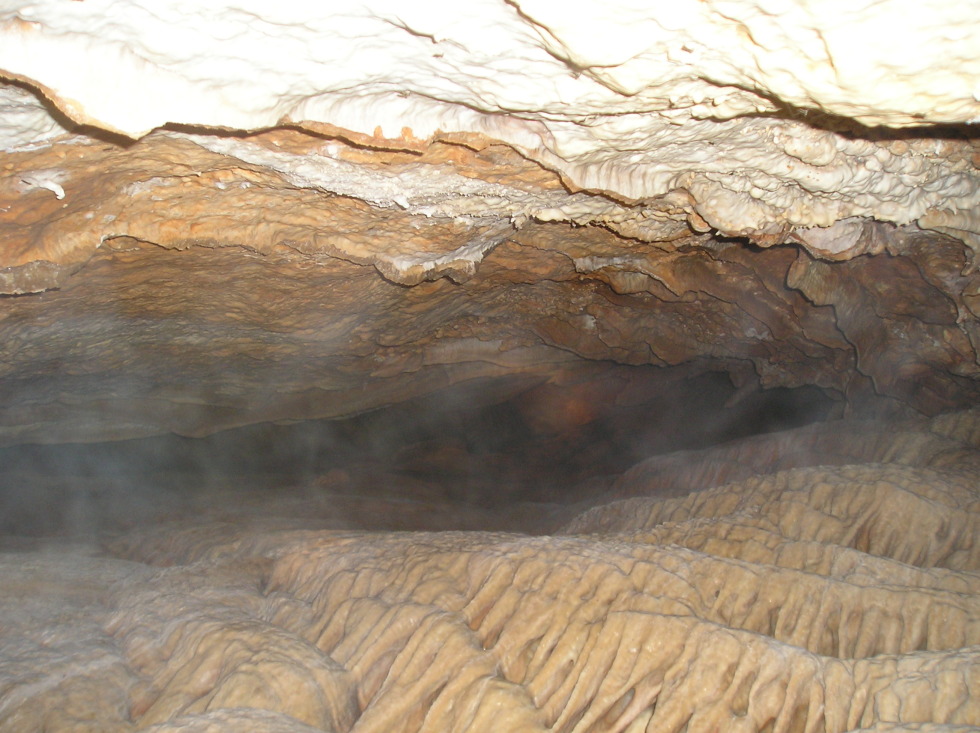
Rača Cave
The oldest evidences of the man’s existence on the island found in the Rača cave are dated to the fourth millennium BC. The excavations in Rača situated in the south-eastern part of the island , near Skrivena luka, revealed a human settlement inhabited from early Stone age till the Roman epoque. The large number of artefacts of the Neolithic Hvar Culture indicate continuous use of Rača over a long “pre-historic” period of time,whereas in the late Bronze Age the cave was probably inhabited only occasionally.
In the cave was found an, even for the east Adriatic area unique,double-bladed razor, round shaped with a cross engraved in the middle.
Rača cave is the only cave on the island in which you can go without fear, it is easy to enter, only bring a flash light !
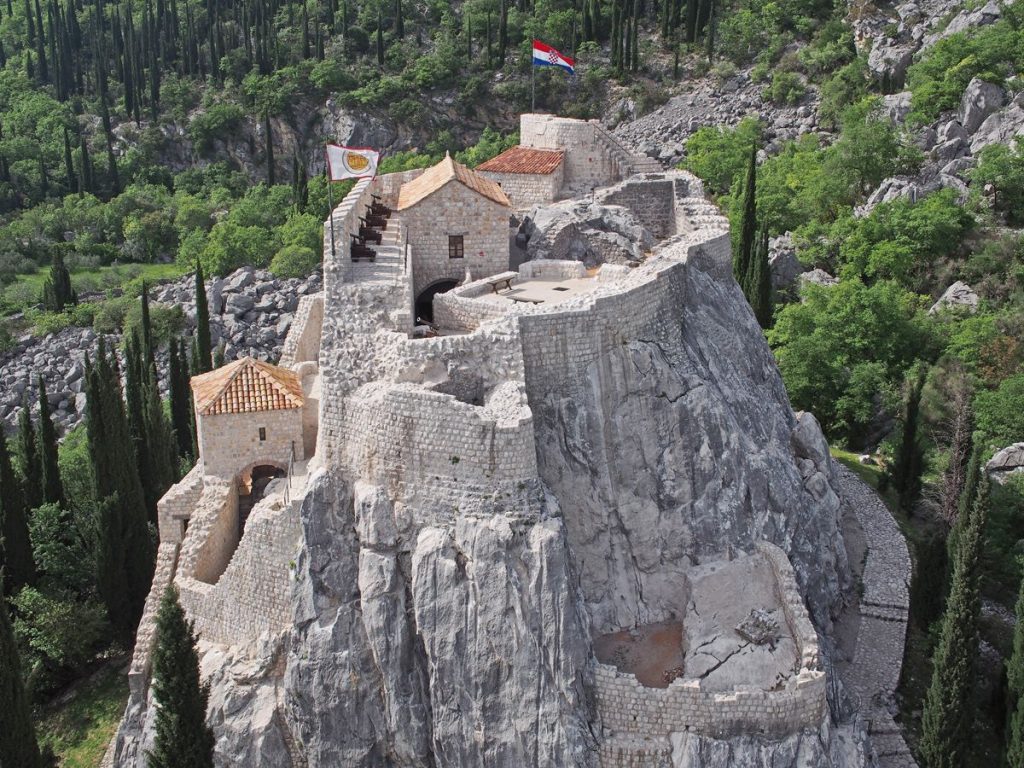 Significant landscapes
Significant landscapes
Kocje
An area not far from the village of Zrnova on the island of Korčula with unique geomorphologic characteristic: boulders, abysses, caves, and canyons, like a labyrinth. Covered with old holm oak woods with a underbrush of coniferous bushes, ferns, moss and lichens.
Dubrovnik River
Flooded river valley, with steep valley cliffs up to 600 metres tall. Numerous old summer residences and parks.
Saplunara
On a diluvial sand base on the island of Mljet, there are well protected macchia thickets and forest vegetation (stone and Aleppo pine woods). This indented coastline is the location of the well known Blace sandy beach.
Badija
The largest island in the archipelago east of Korčula. The main resources on the island are dense macchia thickets, pine woods and the monastery and Church from the 15th century.
Modro Oko and Desna Lakes
This area is one of the representative areas for the specific landscape of the lower course of the Neretva. It is characterized by flooded karsts depressions with an abundance of waters and wetland biotopes.
Konavoski Dvori
The source of the Ljuta River in Konavle: this landscape is a valuable hydrological zone with a series of waterfalls, which represent cultural-historical significance.
Vela Luka – Island Proizd
The beach of the year on the Adriatica coast 2007
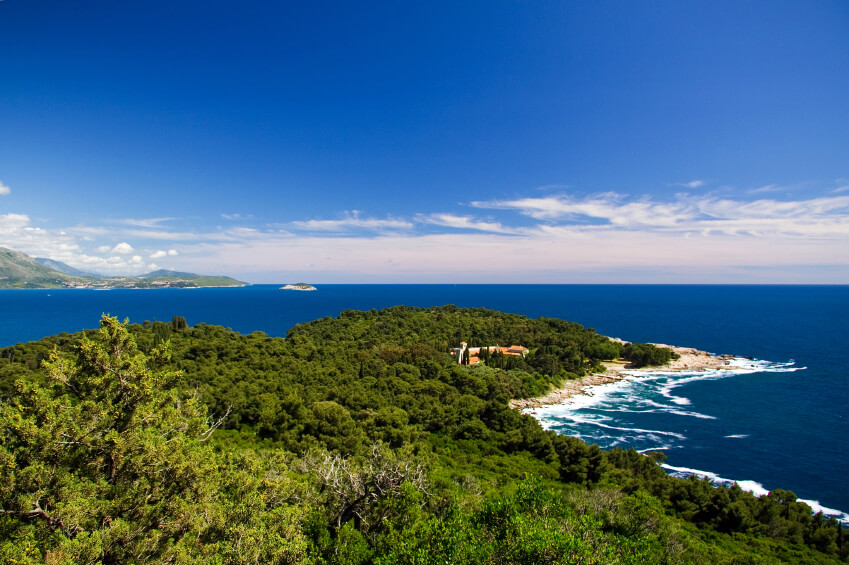 Special reserves
Special reserves
Pod Gredom
The remnants of the Mediterranean wetland region in the lower course of the Neretva River, near Vid. Significant for migration and a wintering ground for birds.
Prud
The remnants of the Mediterranean wetland area in the lower course of the Neretva River, near Prud. A very significant location for migration and a wintering ground for birds.
Orepak
The remnants of the Mediterranean wetland area in the lower course of the Neretva River. A very significant location for migration and a wintering ground for birds.
Mrkan, Bobara and Supetar
Islands near Cavtat, the nesting site for the yellow-legged gull.
Mouth of the Neretva River
Ichthyology-Ornithology Reserve
The southeast part of the Neretva River delta; a spawning site for numerous fish species, important for the migration, wintering and nesting of birds. This region is visually appealing to the “average” tourist, and it is easily accessible via a road which leads directly to the mouth.
Gulf of Mali Ston
Maritime Reserve
Covers the entire sea environment southeast of the line Sreser-Duba, as well as the surrounding coastal belt. Due to the specific hydrographical characteristics and the natural flow of nourishing nutrients from the coast, the maritime zone is highly biologically productive. This is a well known aquaculture site and the culinary centre of the county.
Lokrum
A forest vegetation reserve – an islet near Dubrovnik. Forest of holm oak and macchia thickets with Aleppo pine.
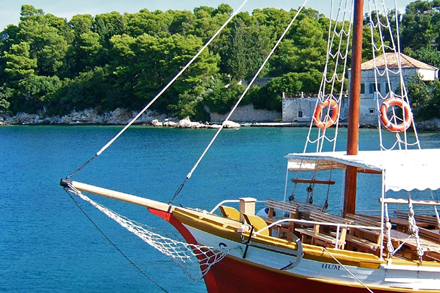 The Elaphite Islands
The Elaphite Islands
The island group includes eight islands and five isles, of which only three are inhabited: Koločep, Lopud and Šipan.
The Island of Koločep is the one closest to Dubrovnik. The settlements Gornje Čelo and Donje Čelo are situated in the two largest bays. The eastern and western parts of the island are covered with thick pine woods stretching as far as the sea rocks. The crystal azure sea abounds with fish and shellfish. The dwellers of Koločep used to be the best-known coral divers in the Mediterranean, but today they seldom dive and only for pleasure.
Numerous monuments including the remains of sarcophaguses, stone sculptures, chapels and churches show that the island was inhabited in the time of antiquity.
Already the first encounter with Kalamota, as the people of Dubrovnik nick-name the Island of Koločep, will not leave you indifferent. You will be intoxicated by its deafening silence, the scent of the Mediterranean herbs and pines, and the blueness of the sea that washes its sandy beaches.
The one standing in the middle is the Island of Lopud, which abounds with beautiful sandy beaches. A boat will take you to the settlement of the same name, from where you can walk to the unique sandy Bay of Šunj on the opposite side of the island. Šunj is a well-known sandy beach, of which one part is reserved for naturists. Nature is not the only one who was generous to Lopud. The island also abounds with forts, little churches, summer residences and monasteries housing valuable works of art.
Do not miss the easy early evening walk to Cape Benešin while the sun goes down into the sea, and visit the unique light installation, the art pavilion Your Black Horizon (www.tba21.org , www.tba21-croatia.org). Set in the rich renaissance environment of Lopud and preserved nature, it gives the landscape a new meaning.
The biggest and most inhabited, the Island of Šipan has a large number of vineyards and olive groves. The two biggest settlements are Šipanska Luka and Suđurađ. The inner side of the island abounds with shelters and natural anchorages of immense beauty, where the branches of pine trees reach the surface of the sea.
In this small area there is a huge number of monuments, more than thirty churches, several monasteries and about sixty summer residences in gothic-renaissance style.
The island dwellers are well-known for their hospitality. They will be happy to take you fishing and into the field, and will offer you healthy food and excellent wines from their fruit-bearing vineyards.
You can reach the Elafite Islands by a boat departing from Gruž Harbour several times a day, or you can join some of the numerous tours organised by the Dubrovnik agencies.
Jadrolinija
Obala Stjepana Radića 40
Tel: +385 20 418 000
Fax: +385 20 418 111
www.jadrolinija.hr
Lopud Tourist Information Office
Obala Iva Kuljevana 12
Tel: +385 20 759 086
Šipan Tourist Information Office
Tel: +385 20 758 084
- Arboretum
-
 Arboretum
ArboretumArboretum Trsteno is the sole arboretum at the Croatian Adriatic coast which unites cultural and natural heritage in a unique abundance of values. It is known for its historical gardens and a collection of Mediterranean and exotic plant species. The collection of cultivated species of plants, which is mostly located within the Renaissance garden, today amounts to about 465 taxa, which are classified into 111 families. According to the plant-geographic origin of the species, the largest number belongs to Mediterranean and European plants (31%), followed by Asian (22%), and a significant number of American plants (17%).
The Arboretum was established at the former land estate of the Dubrovnik patrician family Gučetić-Gozze in 1948 and has been protected by law as a monument of garden architecture. On its 25.61 hectare area (64 acres), the Arboretum integrates several different units: the historical Renaissance garden and villa, the historical neo-romantic garden from the beginning of the 20th century, the historical olive grove, as well as the natural vegetation of the downy oak, the Aleppo pine and the Mediterranean cypress woods, mscchia and coastal rock vegetation.
- Baćina Lakes
-
 Baćina Lakes
Baćina LakesBacina Lakes are a frequent tourist destination and a place of beauty which must be visited. They abound in freshwater fish, but there are also grey mullets, which made the lakes their natural habitat after the tunnel drilling. This region is most famous for its gastronomic specialities. Eels, black water hens and frogs legs, amongst others, are specialities of the Dalmatian kitchen and present an excellent reason to visit the area. The area is a true promised land for nature-lovers and anglers.
On the locality of Sladinac are the remains of antique walls and mosaics belonging to the Roman habitation Praetoria. The remains of an early Christian basilica from the 6th century have been found here. A necropolis of stelae, mostly sarcophagi and slabs, has been found next to the ruins of the church of St. Andrew.
Trade brought the ancient Greeks to this area, and during the time of ancient Rome the area was a part of the province of Dalmatia. The city of Narona, located near the lakes, was then one of the largest economic end cultural centres on the Adriatic Coast.
Bacina Lakes, a pearl of unspoiled nature, consist of seven lakes, six of them forming a bluish green necklace. The lakes are located between the Neretva River Delta, the sea and the surrounding mountains, in the place of Bacina, close to Ploce, on the main road (M2).Their names are: Ocusa, Crnisevo, Podgora, Sladinac, Vrvnik and lake Plitko. The entire area of the lakes amounts to some 20 square kilometers. Their depths range from 5 to 50 m. The water in the lakes is brackish, meaning they are connected with the sea. The lakes are a cryptodepression, because the surface of the lakes lies 80 cm above sea level and the bottom of the lakes lies below sea level. Therefore, salty water can be found at the bottom of the deepest, 50 m deep ,lake Crnisevo. The lakes have two water sources. One of them is a salt water source in lake Crnisevo, and the other one, a natural fresh water source, in lake Ocusa.
- Caves - Mljet
-
 Caves – Mljet
Caves – MljetOdysseus cave
On the south part of the island you can find Odysseus cave which is an geomorphology phenomena. It is a karst hole which looks like a pit. It is connected with open sea by small and low tunel, through wich it is possible to pass just during nice weather. Along the coast you can find couple of little boats, which are in propriety of local people from Babino Polje, and Babino Polje is the biggest village on the island. According to legend, after his shipwreck on the island of Ogigija, Odysseus spent seven years looking at offing to his home and beloved Penelopa, while beautiful nymph Kalipso, Posejdon’s daughter, was looking at the same time, with love, at Odysseus.
- Ecology
-
 Ecology
EcologyEcologically, the entire county is extremely valuable and much attention is given to the conservation of nature and preserving cleanliness.
According to the claims made in 1978 by famed explorer Jean-Jacques Cousteau, Dubrovnik and the surrounding areas boast the cleanest sea in the Mediterranean.
According to the estimates of the assessment team of the European Foundation for Environmental Education, the environment of the Miho Pracat Marina was awarded a “Blue Flag”. The “Blue Flag” symbolizes a preserved, safe and comfortable environment suitable for rest, recreation and sport. For beaches and marinas, flying the blue flag means top quality tourism promotion, which is based on the high quality of service, the cleanliness of the sea and coastline and the facilities and cleanliness at the beaches and sea.
- Flora and fauna
-
 Flora and fauna
Flora and faunaThe combination of luxuriance and an active attitude of the population through the century have made this region exception in the sense of the wealth, beauty and lushness of the vegetation. In addition to autochthonous Mediterranean species of plants, this region is abundant in various subtropical and continental flora species, which are grown in numerous gardens among the Dubrovnik summer homes spread throughout the whole of the Dubrovnik coast and the islands. This region receives a particular charm from the numerous plantations of lemon trees, orange tree and various palms and agave plants, in addition to forests of Aleppo pine and holm oak, and various species of macchia (strawberry tree, heather and Spanish broom). The sea is rich in both flora and fauna. There are abundant colonies of brown, green and red algae. Many animal species can be found living on or near the sea floor, the majority of which spent most of their time living among the algae, while others prefer the sheer underwater cliffs and others yet live hidden among the cracks in the limestone or cliffs. In the dense algae, many species of fish can be found roaming in search of a tasty bite: grey mullet, saddled bream, painted comber and the annular sea bream. Fish species that live on the rocky sea bottom include the sea bass, common dentex, red scorpionfish, comber, common pandora and others. Various species of crabs, shellfish and octopus can be found hiding among the rocks on the sea floor. Here one can also find many shellfish, oysters and mussels. Also in this habitat are the most sought after residents of the southern Adriatic Sea: the lobster, crayfish and large crabs.
The county has a large number of protected nature areas within its territory. Of the total 95 valuable nature areas, 38 are registered and proposals have been made to protect 57. Only recently, scientists of the Dubrovnik Laboratory of the Split Institute for Oceanography and Fisheries discovered a previously unknown species of medusa in the waters of the Malo Jezero (Small Lake) in Mljet National Park. This species of medusa, measuring 55 centimetres in diameter, is estimated to be 26 million years old.
- Flora and Fauna Lastovo
-
 Flora and Fauna Lastovo
Flora and Fauna LastovoThe Lastovo Archipelago is one of the richest and best preserved botanical areas in the Mediterranean. The flora on Lastovo is determined by the isolation of the open sea, plenty of sunlight and night humidity, as well as the special and deep Lastovo soil. There are 810 species recorded so far, including endangered species, species extinct elsewhere, endemic and steno-endemic species.
Besides Aurinia leucadea, an interesting and rare plant, one must point out Ampelodesmos mauretanica, a plant only found on Lastovo, as well as the steno-endemic and strictly protected species Biserrula pelecinus ssp. dalmatica.
The flora on the island of Sušac has been affected by the lack of water on scarce soil and constant exposure to strong southerly winds. This specific flora includes 278 plant species; among the eight endemic ones, one must point out Brassica cazzaem, which grows in the cracks of rocks along and near the shore.
Around 70% of the islands’ surface is covered with forest; besides Mljet, Lastovo has the most forest cover among Croatia’s islands. It is mostly covered with maquis – the most beautiful tree is strawberry tree (Arbutus unedo), but it is significantly covered with holm oak (Quercus ilex) and aleppo pine (Pinus halepensis). Mushrooms can also be found under the forest cover.
Houses on Lastovo are adorned with Mediterranean plants growing around them: almond, lemon, orange, palm and carob trees. This environment also suits medicinal plants such as sage, mint, milfoil, rosemary, lavender, fennel and camomile. Grapevines and olive trees predominate among cultivated plants.
There is also an abundance of animal life. 175 vertebrate species have been recorded so far; 71 of them are endangered at the national and 37 at the European level. Lastovo’s caves host bats that use them either as dens or breeding sites; Medjedina Cave provides shelter for 2 endangered bat species – Geoffroy’s Bat (Myotis emarginatus) and Greater Horseshoe Bat (Rhinolophus ferrumequinum).
The Lastovo Archipelago is an important resting site for numerous migrant birds and also the nesting site for the rare Mediterranean shearwater and Cory’s shearwater (Calonectris diomedea). About 70% of Croatia’s population of the globally endangered Audouin’s Gull (Larus audouinii) nests on the island groups of Lastovnjaci and Vrhovnjaci. Numerous birds of prey nest within the Lastovo Archipelago Nature Park; especially prominent among them are the Peregrine Falcon (Falco peregrinus) and the Eleonora`s Falcon (Falco eleonorae).
It is interesting that there are no venomous snakes on the Archipelago; the only snake is the Caspian whipsnake (Dolichophis caspius). The Lastovo Archipelago is also the habitat of steno-endemic lizards – the Dalmatian ruin lizard (Podarcis sicula adriatica) and the Lastovo wall lizard (Podarcis melisellensis n. ssp.). The area has an abundance of micro-fauna, especially insects, spiders and snails.
- Nature parks
-
 Nature parks
Nature parksThe “Lastovsko otočje” (Lastovo archipelago) Natural Park is the most recent Croatian Nature Park
Lastovo archipelago is the eleventh Natural Park in Croatia. Its total surface area is 195.83 km2. Of this, the land surface area is 52.71 km2 whilst the surface area of the sea is 143.12 km2. The Natural Park consists of all 44 islands, islets, cliffs and reefs that make up the Lastovo Municipality. The largest islands of this group are Lastovo and Sušac. This zone is one of the most protected sea areas in the entire Adriatic. Due to its values and characteristics, it represents an “ample natural and partially fostered land and sea area that has ecologic attributes of national and international importance, with emphasized environmental, pedagogic and educational, cultural and historical as well as tourist and recreational values”. By protecting it, its heritage of environmental and cultural values as well as its biological and environmental diversity, including the sea and sea bed, will be preserved.
- Flora and fauna Korčula
-
 Flora and fauna Korčula
Flora and fauna KorčulaFLORA
The forests of Korčula consist mostly of Aleppo pine (pinus halepensis), coastal pine (pinus maritimus), black pine (pinus nigra), stone pine (pinus pinea) and the evergreen maritime oak “česvina” (quercus ilex).
The wild olive (olea oleaster fiori) can also be found in the woods, as well as the black ash (fraxinus ornus), the prickly juniper (juniperus oxycedrus) and others.
There are numerous cypresses (cypressus sempervirens) near the villages and roads.
A substantial part of the island is covered by “maquis”. Maquis comprises bushes of stunted coastal oak and juniper as well as arbutus (arbutus unedo), myrtle (myrtus communis), European holly (phyllirea latifolia), heather (erica arborea) and other plants. Arbutus (the “strawberry” tree) predominates in the maquis with its white flowers and sweet, bright red fruit. Cultivated bay (laurus nobilis) can be found near the villages and in courtyards.
There are very useful medicinal and aromatic plants sage, rosemary, sweet marjoram, mint. Many wild herbs such as “žutinica” are used in cooking, dressed in olive oil. Mulberry trees (white and black) used to be planted for their valuable wood. Blato has a well-known avenue lined with lime-trees and Korčula has many decorative trees, bushes and plants such as palm, tamarisk, oleander, agave, cactus, Bougainvillea and others.
FAUNA
Korčula has a varied wildlife from beetles to insects and from lizards to birds.
Its fauna includes the biggest European snake – the non-poisonous four-stripe “kravosica” which can grow to 3 metres. A particularly interesting lizard is a cephalopod with stunted legs, which many mistake for a snake, but is in fact a timid lizard useful to man.
Birds are numerous and visitors enjoy their song, from blackbirds to nightingales, as they swoop over the dense woods and fertile fields. Large owls inhabit the pines and among the birds of prey are hawks and falcons. Large flocks of migratory birds use Korčula as a staging post and sea-gulls are an obligatory part of the Korčula landscape.
The sea-gulls are an obligatory part of the Korčula landscape, and large flights of migratory birds arrive on the island during migration.Among the mammals, there are mongoose, martens, weasels and rabbits, but of particular interest is the European jackal (“čagalj”), the last surviving pack of that genus (canis aureus). From the beginning of the eighties, wild boar, which had not hitherto inhabited Korčula, began to cross over to the Dalmatian islands in increasing numbers. The beasts of burden are donkeys and mules; and pigs, goats and sheep are kept for meat and milk.
Korčula’s waters are rich in a broad variety of excellent fish. Some will leap above the surface to be picked off by diving birds.
- Flora and fauna Neretva
-
 Flora and fauna Neretva
Flora and fauna NeretvaThe lower Neretva area is a unique ecosystem rich with many diverse plant and animal species. The river, sea and rocky cliffs have, by working together, created conditions where a myriad of species found ideal places to live and thrive. Neretva is actually known for its diverse habitats, the rivers, meadows, forests of alder and willow, sea shore, but also those made by human hands: the fields, canals, villages. An immense swamp area has, by human interaction, been reduced to a much smaller size, to “patches” and a shadow of what they once were, surounded by swaths of land of cultivated and occupied land. Still, unlike similar lands around the world, the anthropogenic factor hasn’t been too much of a damaging impact to the valley. Its still a land of immense natural riches. Human interaction has resulted in the forestation of the surrounding hills.
In the Neretva valley, by the river mouth, we have developed areas where local plant arts grow in abundance (primorski sit, grmolika caklenjača). The brackishness of the Neretva water is a prerequisite for the rich fish types that live, feed and spawn in its waterways. Although all croatian rivers of the Adriatic Basin allow for the existence of many fish types, Neretva provides sanctuary to a far greater number of freshwater and brackish water fish types. From the most common to the most interesting types for fishing we can mention the many types of mullet and especiallly eel, an odd snake-like fish with a complicated biological cycle. It holds a two thousand year scientific interest, going back as far as Aristotle to Pliny, to the young Sigmund Freud, to modern biologists.
The eel, as is known, is born and dies in the sea, and lives in freshwater streams. There are a lot of secrets and doubts about its lifecycle, but one thing is sure: it’s delicious. The antique writer Athenaeus thought the same, and made an ode to the eel in his “Banquet of the learned”.
Amongst the many amphibians is also the green frog. It is actually a symbol of the area. We can meet it in names of certain places and one (smaller) hill, in the names of historical provinces (Frog District), but usually we’ll find it on the dinner table as one more specific gourmet meal of this area. In the pot it becomes a close companion to the eel with which it makes the traditonal neretvan stew, called brujet.
With the green frog the area is inhabited by many other amphibians and reptiles (which aren’t eaten): copperhead, blavor, karst lizard…
In the surrounding hills and the valley there are also a large number of mammals. In Neretva resides the endangered otter. Apart from the otter there are endangered wolves and wildcats. In the river delta there are 16 freshwater types of the aquatic snail and several types of crab. It’s perfectly reasonable that in such a swampy area there has to be a lot of bugs, and there are 307 types. Butterflies alone take up more than 250 types. You can explore the richness and diversity of the flora and fauna of the Neretva valley in the Natural History museum in Metković.
- Forest parks
-
 Forest parks
Forest parksKoločep – Gornje Čelo
Aleppo pine woods with macchia thickets on the northwest part of the island of Kolocep.
Koločep – Donje Čelo
The forest on the southern part of the island of Koločep is made up of macchia thickets along the beach, as well as individually planted trees of exotic species (eucalyptus, acacia).
Osjak
An island in the Bay of Vela Luka, Aleppo pine woods.
Orebić – cypress trees “Pod Gospu”
Pyramid cypress and Aleppo pine woods on a slope next to the sea under the Franciscan Monastery of the Assumption.
Korčula – Park Hober
Just south of the city of Korčula is a Aleppo and stone pine wood, with an underbrush of macchia thickets, as well as individual pyramid and horizontal cypress, cedars, Spanish fir and agave plants.
Predolac – Šibanica
A forest east of Metković, a protected complex of Aleppo pine and pyramid cypress woods with elements of macchia thickets. Viewpoint of the Neretva valley.
- Geomorphological monuments
-
 Geomorphological monuments
Geomorphological monumentsSpila Nakovana (Cave)
An unusual discovery recently turned public attention to the historical heritage of the Pelješac peninsula. Just above the village of Nakovana, in a cave called “Spila”, archaeologists discovered and studied the remains of an Illyrian shrine dating back to the Hellenist period (4th to 1st century before Christ). The entrance into the shrine was closed off by stones, and it was therefore left untouched since it was abandoned, two thousand years ago. Once the stones to the entrance were removed and the archaeologists could pass through the narrow and low passageway, they entered into a large cave hall. On the floor of the hall were thousands of shards of fine ceramic glasses, jugs, plates and small amphora. These precious and luxurious dishes were produced in the workshops of Greek colonies in southern Italy and on the Adriatic, as well as in Greece, and they came to Illyrian Pelješac through trade or by pirates. Virtually all the dishes were left before a single, 60 centimetre high stalagmite of a phallic shape. Many fine dishes for drinks and serving food and bones from goat and lamb legs testify to the ritual feasts held here. The sacrificial gifts were laid at the foot of the stalagmite, a remarkable symbol of a superhuman creature who was worshipped in the cave. We can only guess as to the attributes of this “deity”, however, the very shape of the stalagmite suggests that this cult was tied to fertility, potency or strength and courage in combat. In the final, restless centuries of pre-history, these were the most esteemed characteristics. The cave near Nakovana is the only well preserved and completely studied Illyrian shrine we know of. This is also the only “sealed” cave finding in Croatia discovered by archaeologists, and not by passers-by, such that its scientific potential has remained completely preserved. For this reason, we expect that the analysis of the findings in the cave, which are currently ongoing, will tell us much about the details of the spiritual life of the Illyrians and their gradual coexistence with classical Mediterranean civilizations.
Mocile Cave
Dry, horizontal cave near the village Pobrežje near Dubrovnik
Sipun – cave
Cave near Cavtat, interesting for its virtually completed blackened walls, fragments of ceramic dishes have been found. There is a small lake within the cave.
Raca – cave
Cave on the island of Lastovo, archaeological site.
Vela Spilja (Great cave)
Cave near Vela Luka on the island of Korcula.
Gromača Cave
Cave with a pit entrance, developed network of tunnels on several levels. Traces of footprints by early cavemen.
- Kočje
-
 Kočje
KočjeAs one enters the village coming from Korčula, there is a road leading off to the right to Brdo (0.5km). Brdo is part of the village perched high on the hill, from where one can walk to Kočje (2.5km), through a pleasant landscape containing dolomite rock formations.
Korčula is the most densely wooded of the larger Croatian islands, with 61% of its surface forested. The remainder comprises olive groves, vines and other cultivation. Less than 5% is bare rock.
- National park Mljet
-
 National park Mljet
National park MljetSituated on the island of the same name, Mljet National Park is the most important protected area of the Dalmatian south. It is the oldest National Park at the Adriatic. The park covers the western part of the island, which many regard as the most alluring in the Adriatic, full of lush and varied Mediterranean vegetation. The park includes two deep bays which, due to their extremely narrow links with the sea, are regarded as and indeed named lakes: the Great Lake and the Small Lake. Mljet is also very rich in cultural heritage, the most prominent example being the complex of the 12th century Benedictine monastery. The monastery is located on a small island in the middle of the Great Lake and is set in a lush park. Over the course of centuries, numerous chronicles, dissertations and other literary works have been written here. Located within the monastery is the church of St Mary.
For more information please visit: http://np-mljet.hr/en/
Contact
Tel: ++385 20 744 041
Fax: ++385 20 744 041
E-mail: np-mljet@np-mljet.hr
Web: www.np-mljet.hr
Address: Pristanište 2, 20226 Goveđari - Natural heritage of island Mljet
-
 Natural heritage of island Mljet
Natural heritage of island MljetGeographically, Mljet is located in the open sea on the southeast Adriatic. Its location determines clime and vegetation on the island which is famous by its natural heritage: lakes, bays, sources of drinking water, steeply and rocky coast, preserved forests of holm oak tree and aleppo pine, caves, sandy coves… Those are some of the reasons why in 1960. northwest part of the island, with its area of 3000 ha, became national park. Institution for preserving natural heritage was founded in the same year.
Mljet is hilly island, the highest point is Veliki grad with its 514 meters and it is located in middle part of the island. Cliffs are made of limestone and dolomite. There are no water courses on the island, but there are several sources of drinking water. Great and Small lake on the northwest side of the island are submerged kasrst valleys filled by sea. Coastline on the island is rugged; there is great number of islets, coves and reefs.
Fauna
Rich and the interesting fauna of the island has not been fully explored yet.
From the reptiles there are a road lizard (Lacerta viridis), Sharp-lizard (Lacerta oxycephala), common lizard (Lacerta melisellensis) and the pet gecko (Hemidactilus turcicus). Snakes are quite rare (there are no poisonous) after they brought the mongoose (Herpestes auropunctatus) 1909th year. After an initial rapid increase, mongoose populations came to a certain balance with the environment.
From the mammals there are: mouse (Apodemus mystacinus), hedgehog (Erinaceus europeus), more species of bats (Chiroptera), common dormouse (Glis glis), marten (Martes foina) and common hare (Lepus europaeus). Fallow deer (Dama dama) was entered on the island after the Second World War, and more recently wild boar (Sus scrofa).
Bird world is rich and the diverse especially in the migrating season. In pine woods and the surrounding macchia live thrushes (Turdidae), tit (Paridae), Queen (Regulidae), warbler (Sylvidae) _ Hoopoe (Upupa epops), Roller (Coracias garrulus), etc. Valleys and the fields in the winter time are populated by Finch (Fringilidae), Lark (Alaudidae) and the shepherdesses (Motacilidae). Along the coast and especially on the mud lakes there are: mallards (Anatidae), grebes (Podicipidae), herons (Ardeidae) and the snipe (Scolopaeidae). In migrating here are many Falconiformes (Falconidae), and ring dove (Columba palumbus) and the stock dove (Columba oenas). At the Park nests wild pigeon (Columba livia) and the rare prey eagle owl (Bubo bubo).
The sea around the island is characterized by well preserved wildlife, distinctive from southern Adriatic.
- Neretva estuary
-
 Neretva estuary
Neretva estuaryThe last delta of Europe – richness at the Neretva estuary
In addition to the beautiful islands, mountains, karst and fertile hinterland, Dalmatia is proud of the latest Delta of Europe – Neretva river mouth.
The delta of the Neretva River, from Metković to the estuary on the north and northeast, is bordered by branches of the Dinaric Alps, and to the south by hills. To the west it is open to the sea and is under its constant influence. Precisely this brackish water is the right place for the growth of vegetation and fish fund. The wildlife is also diversified here – the last species of birds, which couldn’t be seen anywhere else in Europe, made their nests in this marsh area.
Climatic influences are very suitable for agriculture, for the famous Neretva tangerines and other citrus fruits, among which in the past years clementines have become increasingly popular, whereas at the beginning of the summer, it is all about peaches and nectarines. Precisely picking these cultures for years also represents a type of tourism that Neretvians have arranged for their guests. We must not forget hunting and fishing, which also brought many at the Neretva river delta… and after hunting and eels fishing, you can try preparing these delicacies, typical for this region.
In addition to these activities, even if you are not the athletic type, you will surely enjoy the photo safari through the backwaters of the river. A ride in the Neretva boat (you can paddle on your own, or choose a motor drive) through the vast backwaters, tributaries and lakes, finalized with occasional lunch at one of the many ranches (with an outdoor barbecue and homemade bread), will make one of the best memories. The Neretva River delta is a natural phenomenon, and a must-see!
- Rača Cave
-

Rača Cave
The oldest evidences of the man’s existence on the island found in the Rača cave are dated to the fourth millennium BC. The excavations in Rača situated in the south-eastern part of the island , near Skrivena luka, revealed a human settlement inhabited from early Stone age till the Roman epoque. The large number of artefacts of the Neolithic Hvar Culture indicate continuous use of Rača over a long “pre-historic” period of time,whereas in the late Bronze Age the cave was probably inhabited only occasionally.
In the cave was found an, even for the east Adriatic area unique,double-bladed razor, round shaped with a cross engraved in the middle.
Rača cave is the only cave on the island in which you can go without fear, it is easy to enter, only bring a flash light !
- Significant landscapes
-
 Significant landscapes
Significant landscapesKocje
An area not far from the village of Zrnova on the island of Korčula with unique geomorphologic characteristic: boulders, abysses, caves, and canyons, like a labyrinth. Covered with old holm oak woods with a underbrush of coniferous bushes, ferns, moss and lichens.
Dubrovnik River
Flooded river valley, with steep valley cliffs up to 600 metres tall. Numerous old summer residences and parks.
Saplunara
On a diluvial sand base on the island of Mljet, there are well protected macchia thickets and forest vegetation (stone and Aleppo pine woods). This indented coastline is the location of the well known Blace sandy beach.
Badija
The largest island in the archipelago east of Korčula. The main resources on the island are dense macchia thickets, pine woods and the monastery and Church from the 15th century.
Modro Oko and Desna Lakes
This area is one of the representative areas for the specific landscape of the lower course of the Neretva. It is characterized by flooded karsts depressions with an abundance of waters and wetland biotopes.
Konavoski Dvori
The source of the Ljuta River in Konavle: this landscape is a valuable hydrological zone with a series of waterfalls, which represent cultural-historical significance.
Vela Luka – Island Proizd
The beach of the year on the Adriatica coast 2007
- Special reserves
-
 Special reserves
Special reservesPod Gredom
The remnants of the Mediterranean wetland region in the lower course of the Neretva River, near Vid. Significant for migration and a wintering ground for birds.
Prud
The remnants of the Mediterranean wetland area in the lower course of the Neretva River, near Prud. A very significant location for migration and a wintering ground for birds.
Orepak
The remnants of the Mediterranean wetland area in the lower course of the Neretva River. A very significant location for migration and a wintering ground for birds.
Mrkan, Bobara and Supetar
Islands near Cavtat, the nesting site for the yellow-legged gull.
Mouth of the Neretva River
Ichthyology-Ornithology Reserve
The southeast part of the Neretva River delta; a spawning site for numerous fish species, important for the migration, wintering and nesting of birds. This region is visually appealing to the “average” tourist, and it is easily accessible via a road which leads directly to the mouth.Gulf of Mali Ston
Maritime Reserve
Covers the entire sea environment southeast of the line Sreser-Duba, as well as the surrounding coastal belt. Due to the specific hydrographical characteristics and the natural flow of nourishing nutrients from the coast, the maritime zone is highly biologically productive. This is a well known aquaculture site and the culinary centre of the county.Lokrum
A forest vegetation reserve – an islet near Dubrovnik. Forest of holm oak and macchia thickets with Aleppo pine.
- The Elaphite Islands
-
 The Elaphite Islands
The Elaphite IslandsThe island group includes eight islands and five isles, of which only three are inhabited: Koločep, Lopud and Šipan.
The Island of Koločep is the one closest to Dubrovnik. The settlements Gornje Čelo and Donje Čelo are situated in the two largest bays. The eastern and western parts of the island are covered with thick pine woods stretching as far as the sea rocks. The crystal azure sea abounds with fish and shellfish. The dwellers of Koločep used to be the best-known coral divers in the Mediterranean, but today they seldom dive and only for pleasure.
Numerous monuments including the remains of sarcophaguses, stone sculptures, chapels and churches show that the island was inhabited in the time of antiquity.
Already the first encounter with Kalamota, as the people of Dubrovnik nick-name the Island of Koločep, will not leave you indifferent. You will be intoxicated by its deafening silence, the scent of the Mediterranean herbs and pines, and the blueness of the sea that washes its sandy beaches.
The one standing in the middle is the Island of Lopud, which abounds with beautiful sandy beaches. A boat will take you to the settlement of the same name, from where you can walk to the unique sandy Bay of Šunj on the opposite side of the island. Šunj is a well-known sandy beach, of which one part is reserved for naturists. Nature is not the only one who was generous to Lopud. The island also abounds with forts, little churches, summer residences and monasteries housing valuable works of art.
Do not miss the easy early evening walk to Cape Benešin while the sun goes down into the sea, and visit the unique light installation, the art pavilion Your Black Horizon (www.tba21.org , www.tba21-croatia.org). Set in the rich renaissance environment of Lopud and preserved nature, it gives the landscape a new meaning.
The biggest and most inhabited, the Island of Šipan has a large number of vineyards and olive groves. The two biggest settlements are Šipanska Luka and Suđurađ. The inner side of the island abounds with shelters and natural anchorages of immense beauty, where the branches of pine trees reach the surface of the sea.
In this small area there is a huge number of monuments, more than thirty churches, several monasteries and about sixty summer residences in gothic-renaissance style.
The island dwellers are well-known for their hospitality. They will be happy to take you fishing and into the field, and will offer you healthy food and excellent wines from their fruit-bearing vineyards.
You can reach the Elafite Islands by a boat departing from Gruž Harbour several times a day, or you can join some of the numerous tours organised by the Dubrovnik agencies.
Jadrolinija
Obala Stjepana Radića 40
Tel: +385 20 418 000
Fax: +385 20 418 111
www.jadrolinija.hrLopud Tourist Information Office
Obala Iva Kuljevana 12
Tel: +385 20 759 086Šipan Tourist Information Office
Tel: +385 20 758 084






